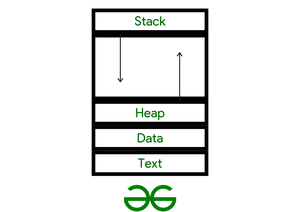临时数据如方法/函数参数、返回地址和局部变量存储在进程堆栈中,而另一方面,CPU 堆栈由一组数据字组成。它采用后进先出 (LIFO) 访问技术,这是大多数 CPU 中最常见的。在本文中,我们将找出这两者之间的详细区别。
1. 进程堆栈示例:
C
#include
int main() {
printf("Geeks for Geeks \n");
return 0;
} C
#include
int GeeksforGeeks(int parameter1, char parameter2)
{
int local1 = 9;
char local2 = 'Z';
return 0;
}
int main(int argc, char* argv[])
{
GeeksforGeeks(7, '9');
return 0;
} 输出
Geeks for Geeks 分析:此代码仅打印出一行,因为这仅限于一个进程,该进程在完成后终止。

2. CPU 堆栈示例:
C
#include
int GeeksforGeeks(int parameter1, char parameter2)
{
int local1 = 9;
char local2 = 'Z';
return 0;
}
int main(int argc, char* argv[])
{
GeeksforGeeks(7, '9');
return 0;
}
输出 :
int main(int argc, char *argv[])
{
00401060 push ebp
00401061 mov ebp, esp
00401063 sub esp, 40h
00401066 push ebx
00401067 push esi
00401068 push edi
00401069 lea edi, [ebp-40h
0040106C mov ecx, 10h
00401071 mov eax, 0CCCCCCCCh
00401076 rep stos dword ptr [edi]}分析:如您所见,这些都是在运行此程序时显示的不同 CPU 寄存器,因为 CPU 堆栈是一个更大的进程。

进程堆栈和 CPU 堆栈之间的区别:
|
Process Stack |
CPU Stack |
|---|---|
| Each process has its own Process Control Block (PCB) to save such information on a context switch, allowing the scheduling algorithm to function on a basic process ID. | Each process doesn’t own its own PCB, hence status of a process is also contained in the registers to be stored for eviction. |
| The PCB associated with that ID is restored when a process obtains the CPU. | The PCB associated with that ID is not restored unlike Process Stack. |
| A stack is nothing more than a memory block. | It consists of several memory blocks grouped together. |
| Each processor mode generally has its own stack in a process. Each thread in multithreading has its own stack. | Each CPU mode generally posses a unique stack. There can be several stacks in a process. |
| When a context transition happens, the kernel “kicks out” the old process and brings in a new one. | When context transition happens, its prior state is restored in order for it to resume execution where it left off. |
| There are a finite number of registers in every architecture. | Saving registers on the stack is for efficiency’s sake, so all you have to do now is re-enter the values. |
| Local variables are stored in the Stack. When local variables are declared, space on the stack is set aside for them. | The stack pointer increases to the next physical memory location when a new data item is inserted or “pushed” onto the top of a stack, and the new item is copied to that address. |
综上所述,这些就是差异,希望本文能帮助您识别它们,另外请注意,尽管两者听起来有些相似,但细微的变化却无处不在。